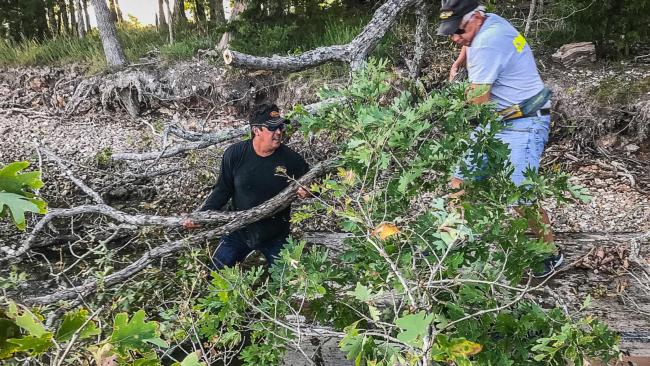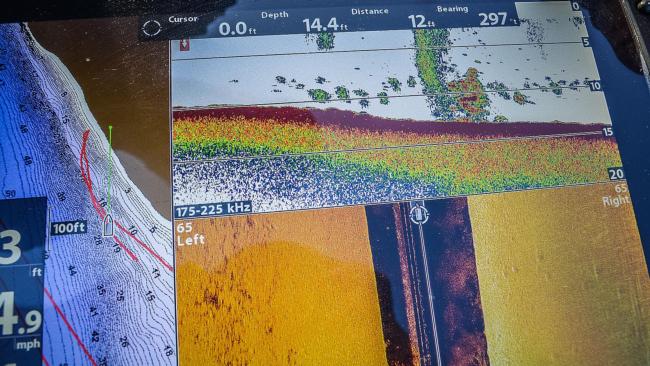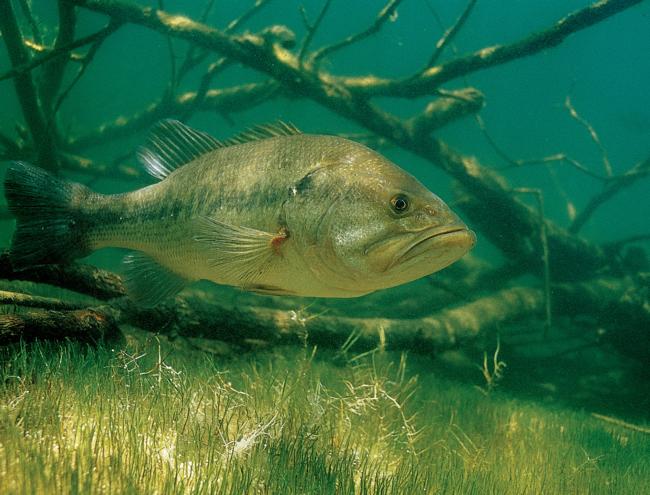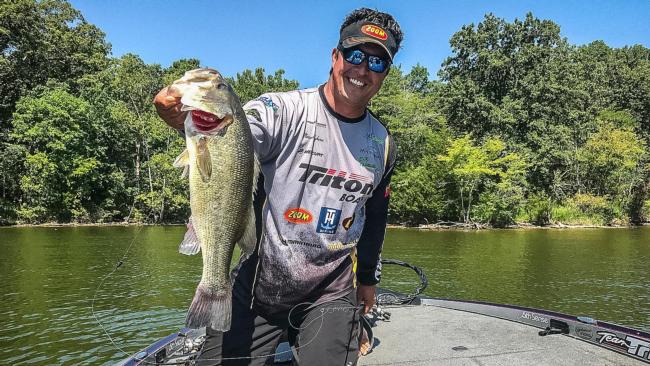Planting Brush the Right Way
How Marcus Sykora and Bill Davenport place key fish-holding cover for year-round success
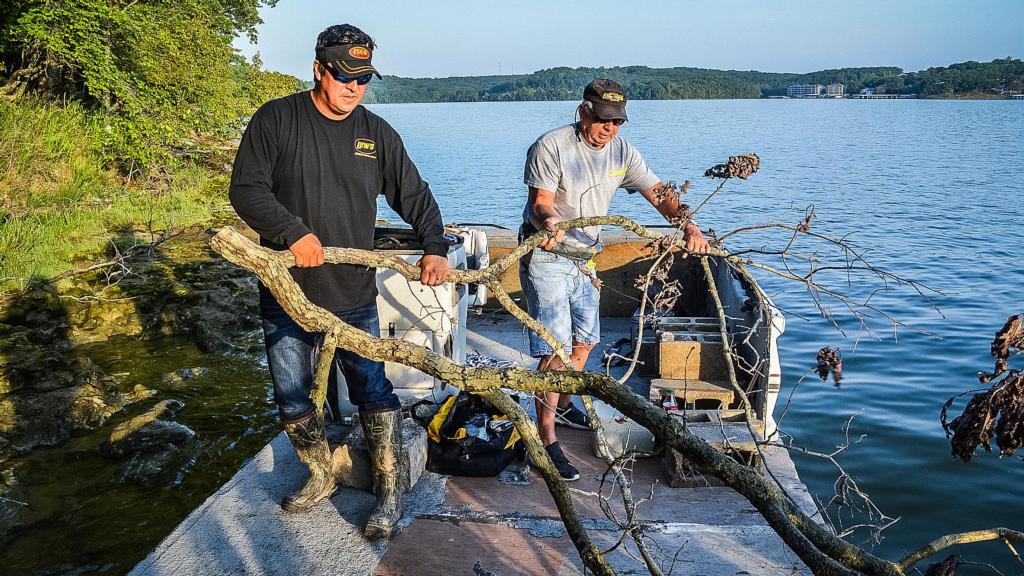
Marcus Sykora casts a low profile when he sinks brush piles in Lake of the Ozarks.
He leaves his shiny bass boat at home and heads out in a beat-up pontoon with a long wooden platform and only one tattered seat.
“This isn’t exactly our party boat,” Sykora says with a laugh. “This our work barge.”
Still, it might be the most valuable boat in Sykora’s fleet. The 29-foot-long pontoon with a 90-hp motor has one purpose: It’s a brush transporter.
Throughout the year, Sykora and his longtime friend and fishing partner, Bill Davenport, use the old pontoon to sink dozens of brush piles in Lake of the Ozarks.
They’re master builders when it comes to constructing fish homes. They’ve put out more than 1,000 brush and rock piles in the sprawling Lake of the Ozarks over the years. And that translates to plenty of places to fish.
Sykora and Davenport have teamed to win many buddy tournaments on the big lake, and the former has found success on a broader scale, taking championships in eight T-H Marine FLW Bass Fishing League tournaments (five at Lake of the Ozarks), plus the 2014 BFL All-American at Wilson Lake.
Sykora runs a successful State Farm Insurance business in Osage Beach, Mo. But he also spends plenty of time on the water at Lake of the Ozarks –fishing and creating spots to fish.
“The guy who owned this boat before used it for dock repair,” says Sykora, 40. “When I bought it, I tore out the seats and rails and left just a big wood platform. The only thing we use this for is putting out brush.”
Stealth and construction
Recently, I joined Sykora and Davenport on a hot summer day to see how they “manufacture” some of their best brush pile spots.
The timing was perfect for a stealth mission. It was a weekday, and there wasn’t much traffic on the water. Plus the 95-degree temperatures kept others inside during the peak of the day.
“You don’t want to be out here sinking brush where a lot of other fishermen will see what you’re doing,” Sykora says. “We try to find times when there aren’t many people around.”
Davenport guided the boat to a secluded bank where the two fishermen had gathered big piles of oak and sycamore limbs, and they began building bundles of fish cover.
“The nice thing about oak and sycamores is that they’re a hardwood and they’ll last for a while,” Davenport says. “And the limbs have enough gaps in them that you can get a bait through there.”
Davenport and Sykora also like to use cedars and blackjack, a type of oak, when they can find them, again because they’re long-lasting. They avoid sinking Christmas trees like many fishermen use.
“They won’t last very long, maybe a year at the most,” Sykora says. “And their limbs are so tight, it’s hard to get a lure through there.”
The two fishermen avoid massive brush piles. They are too easy for others to find. Instead, they prefer to build bundles that are 15 to 20 feet long and about 4 feet high. They use nylon rope to tie concrete blocks to the limbs and send them overboard.
Location, location, location
There is strategy as to where the brush piles are placed. On this outing, Sykora and Davenport were planning ahead for early fall, when the shad would start migrating from the main lake back into the cuts and coves.
“In early fall, the shad start to migrate and follow the channel,” Sykora says. “We want a pit stop the bass can relate to and ambush shad.”
For spring, Davenport says, they often sink isolated brush piles on gravel banks that are devoid of cover. For summer and winter, they will sink brush up to 25 feet deep.
The common element? Most of the brush piles are sunk in spots near the channel. And they are placed in subtle spots, places where obvious landmarks can’t be used by other fishermen to find them.
Once the piles are sunk, the fishermen will punch their coordinates into a GPS, and they’ll have a ready path back to the cover.
There’s no guarantee that their brush piles won’t be located by other fishermen, though.
“With the advanced electronics available now, it’s not that hard to find brush that other fishermen have put out,” Sykora says. “That’s why we’ll sometimes wait to put out brush until just a couple of days before a tournament, then leave it alone.
“We’ll go back on tournament day, and we’ll have fresh brush that hasn’t been fished. We’ve won tournaments that way.”
Fish attraction
Often, it doesn’t take bass long to locate the new cover. Davenport remembers days when he put brush out and went back several hours later and caught fish off that new cover.
“I have 2,500 waypoints marked in this lake alone,” Sykora adds. “That’s brush we have sunk and piles that others have put out.
“It isn’t easy, but it definitely pays off,” he continues. “We’ve won a lot of tournaments fishing brush we’ve put out.”
He learned his stuff from Davenport, known as one of the best bass fishermen at Lake of the Ozarks. Not long after Davenport started fishing the lake in the early 1970s, he realized how vital man-made brush piles were to finding bass there.
“At a place like Lake of the Ozarks, where there isn’t a lot of natural cover, brush piles can really hold the bass,” says Davenport, 72, who lives in Waynesville, Mo. “But there weren’t a lot of people putting them out at the time. I started building them in 1976, and I’ve been doing it ever since.”
Lake of the Ozarks is an ideal place to sink brush piles. Ameren Missouri, the power company that manages Lake of the Ozarks, allows fishermen to sink fish attractors of naturally woody debris as long as they don’t impede navigation. No permit is required.
At U.S. Army Corps of Engineers reservoirs, regulations on individuals sinking brush differ with each location. However, most allow at least some type of natural cover to be sunk by individuals, provided they get a permit. You’ll need to check the regulations on your fishery before you begin planting any type of cover.
Success rates
Not all of the brush piles will attract fish. Sykora and Davenport indicated that they find success in no more than about 50 percent of the piles they put out.
They fish the brush with a variety of lures: plastic worms and jigs to penetrate the brush, and topwater baits, swimbaits, jerkbaits and crankbaits over the top.
“We don’t just drop the trolling motor and go down a bank,” Davenport says. “We go from spot to spot. We have enough options that we’re usually going to catch something after we’ve moved a few times.”
Sykora proved that on our outing after he and Davenport had sunk 12 brush piles. By late morning, a hot sun was beating down and the temperature had climbed into the 90s. But Sykora returned to brush he and Davenport had sunk previously and quickly found success. As he snaked a plastic worm through the limbs of a brush pile, he felt a slight tap and set the hook. Seconds later, he had a 3-pound bass in the boat.
He tossed that fish back and said, “Let’s see if I can catch one bigger.”
He did. Fishing another brush pile, he landed one that weighed 4 1/2 pounds. All of this on a day when most bass fishermen wouldn’t even think of heading out into the hot doldrums of summer.
“That’s why we put out brush piles for each season,” Sykora says. “We create places to fish for each time of the year.
“With all the electronics today, other fishermen will find some of the brush we put out. But we’d like to think that we can stay one step ahead of them. By the time they find some of our old brush, we’re putting out new stuff.”
